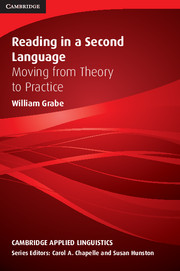I - FOUNDATIONS OF READING
Published online by Cambridge University Press: 05 August 2012
Summary
This first part comprises five chapters that, together, explain how comprehension works, how it can develop over time, and how various cognitive abilities contribute to reading comprehension. This part draws heavily on research in cognitive psychology and educational psychology, and the explanation of reading comprehension presented relies on research primarily carried out in first language (L1) contexts. The major research findings that explain reading comprehension rest primarily on research with learners reading in English as their L1, although there is also considerable and growing research on L1 reading comprehension in several other Indo-European languages as well as in Hebrew, Japanese, and Chinese.
One consequence of the emphasis on L1 reading-comprehension research is that this part is primarily oriented to reading ability more generally rather than to a specific explanation of second language (L2) reading comprehension. There are, in fact, many differences between L1 and L2 reading, and they are addressed in various ways in Part II of this book. However, the basic comprehension process is one that generalizes across L1 and L2 contexts, even if local processing details might vary across different L1s and across L1 and L2 contexts. Complex comprehension abilities are shared across the human species and these abilities apply to more than reading (e.g., listening comprehension, visual comprehension). So it should not be surprising that basic cognitive processes operate in consistent ways across modalities, across languages, and across multiple languages. This recognition of both the universal cognitive architecture for comprehension and specific variations in its operationalization in different language and multilanguage contexts has already been argued persuasively (Geva & Siegal, 2000; Geva & Wang, 2001; Koda, 2007).
- Type
- Chapter
- Information
- Reading in a Second LanguageMoving from Theory to Practice, pp. 1 - 3Publisher: Cambridge University PressPrint publication year: 2008

